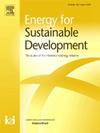Voucher-based liquefied petroleum gas subsidies achieve nearly exclusive clean fuel use when affordable delivery is available
IF 4.9
2区 工程技术
Q2 ENERGY & FUELS
引用次数: 0
Abstract
Introduction
Fuel subsidization can promote clean fuel adoption and reduce household air pollution. We investigated whether a voucher-based system could be as effective as a home-based fuel delivery program in achieving exclusive use of liquefied petroleum gas (LPG) within a randomized controlled trial in Puno, Peru.
Methods
In the first year of the trial, we delivered unlimited LPG to intervention homes, while comparison group participants continued baseline cooking practices. In the second year, comparison group participants received vouchers covering the cost of two 10 kg LPG tanks per month but did not receive tank delivery. We assessed voucher use and compared LPG use between the voucher and home delivery schemes. We conducted qualitative interviews with 15 women to understand perceptions and use of the vouchers and LPG. Data were collected in 2020 but remain relevant given the unchanged LPG system in Peru.
Results
Voucher use was high (97.6 % of vouchers were used). Participants receiving vouchers used LPG for 94.3 % of cooking minutes, which was only slightly lower than the percent of cooking done with LPG by participants who received free home delivery (98.2 %) (p < 0.001). Voucher participants cooked with biomass for 84.7 min per week, within the range estimated as acceptable for meeting the World Health Organization interim air quality targets (<1–3 h per week). Facilitators of voucher and LPG use included the ease and speed of cooking with gas, availability of LPG delivery in the region, access to several nearby LPG distributors, owning a second back-up LPG tank, and reinforcement of exclusive LPG use by study fieldworkers.
Conclusion
A voucher-based system for providing subsidized LPG, paired with a reliable LPG infrastructure and behavioral motivation, effectively achieved near-exclusive clean fuel adoption. Findings can guide the design of LPG subsidization programs, which are increasingly important amid rising global LPG prices.
基于代金券的液化石油气补贴在可负担得起的运输条件下实现了几乎完全的清洁燃料使用
燃料补贴可以促进清洁燃料的使用,减少家庭空气污染。在秘鲁普诺进行的一项随机对照试验中,我们调查了基于凭证的系统是否与基于家庭的燃料输送计划一样有效,以实现液化石油气(LPG)的独家使用。在试验的第一年,我们向干预家庭提供无限量的液化石油气,而对照组参与者继续进行基线烹饪练习。在第二年,比较组的参与者每月获得两个10公斤石油气储罐的费用代金券,但没有收到储罐交付。我们评估了代金券的使用情况,并比较了代金券和送货上门计划之间的液化石油气使用情况。我们对15名妇女进行了定性访谈,以了解她们对代金券和液化石油气的看法和使用情况。数据是在2020年收集的,但鉴于秘鲁的液化石油气系统没有改变,数据仍然具有相关性。结果医疗券使用率高,使用率达97.6%。获得代金券的参与者在94.3%的烹饪时间内使用液化石油气,仅略低于获得免费送货上门服务的参与者使用液化石油气烹饪的百分比(98.2%)(p < 0.001)。代金券参与者每周用生物质做饭84.7分钟,在满足世界卫生组织临时空气质量目标(每周1-3小时)的可接受范围内。促进代金券和液化石油气使用的因素包括:用煤气做饭的便利性和速度、该地区有液化石油气供应、附近有几个液化石油气分销商、拥有第二个备用液化石油气储罐以及加强研究现场工作人员专用液化石油气的使用。基于代金券的补贴液化石油气系统,加上可靠的液化石油气基础设施和行为动机,有效地实现了几乎完全的清洁燃料采用。研究结果可以指导LPG补贴计划的设计,这在全球LPG价格上涨的情况下变得越来越重要。
本文章由计算机程序翻译,如有差异,请以英文原文为准。
求助全文
约1分钟内获得全文
求助全文
来源期刊

Energy for Sustainable Development
ENERGY & FUELS-ENERGY & FUELS
CiteScore
8.10
自引率
9.10%
发文量
187
审稿时长
6-12 weeks
期刊介绍:
Published on behalf of the International Energy Initiative, Energy for Sustainable Development is the journal for decision makers, managers, consultants, policy makers, planners and researchers in both government and non-government organizations. It publishes original research and reviews about energy in developing countries, sustainable development, energy resources, technologies, policies and interactions.
 求助内容:
求助内容: 应助结果提醒方式:
应助结果提醒方式:


